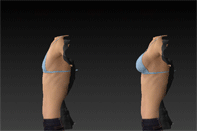Breast implants and augmentation procedures have the power to transform the lives of women who get them. Improved self-esteem, quality of life, and sexual satisfaction are just a few of the many reasons that women opt to have the procedure performed.
As the life expectancy of the average person in the U.S. increases to upwards of 80 years, more and more women are looking—and feeling—younger than ever. “60” is now the new “40,” and this means many women still actively care about how they look once they reach middle age.
Many plastic surgeons have reported that they are seeing a massive uptick in women over the age of 40 who are wanting to get breast augmentation. One of the most common questions they hear is, “Am I too old for this procedure?”
We’re going to explore if there is a cut-off age for breast augmentation surgery and whether or not women over 40 face an increased risk of complications.
Average Age of Breast Augmentation Patients
In 2018, there were 313,735 breast augmentation procedures performed in the U.S. Out of those, the average age of the patient was around 34 years of age. The earliest that women can get implants is 18 years of age—but only saline ones.
As per FDA standards, women are only permitted to undergo augmentation with silicone implants when they reach 22 years of age. The reason for this rule is because women’s bodies continue to grow and mature well into their 20s. If they get implants at too young of an age, complications may arise as their bodies will continue to develop until they reach their physiological maturity.
Is There an Age Cut-off for Breast Implants?
While there is a cut-off age for younger women who want to get breast augmentation, what about older women?
The FDA doesn’t have a cut-off age limit for breast implants. What they and plastic surgeons are more concerned about is the overall health of the prospective patient. As women get older, there are two distinct types of aging:
Chronological age—how old you are in actual years.
Physiological age—how much your body has worn out over the years.
People who tend to drink and smoke heavily and eat unhealthy foods tend to have a higher physiological age than those who don’t. It’s generally advised that if a woman over the age of 40 wants to get breast implants, she should first check with her primary care doctor. They will be better able to tell her if her body can undergo elective surgery.
Potential Complications for Older Women
There are a few potential complications that older women could experience. If they are in poor health or their bodies have a high chronological age, they might see increased healing times, various aches and pains, and in some cases, complications from the anesthesia.
A study was performed in 2011 that found that women over the age of 50 can experience higher rates of complications—including infections—after breast reduction surgery. It linked the likely increase in risk due to age-related declines in hormone levels.
Generally speaking, women over the age of 40 can experience the same potential complications as someone in their 20’s. There is a slightly increased risk for certain women, and this is why it’s highly recommended they pay a visit to their general practitioner doctor and get their opinion.
Benefits of Breast Augmentation for Older Women
Women who are over the age of 40 can experience a wide range of benefits from undergoing a breast augmentation procedure. For starters, the average age of the start of menopause is around 51 years old. This means that post-menopausal women won’t have the risk of a pregnancy altering or destroying the work the surgeon did.
There are many women out there who are over the age of 50 and don’t look anywhere near it. There’s no valid reason why they shouldn’t undergo a breast augmentation procedure if their primary care doctor gives them the go-ahead. It can help make them look younger, increase their self-confidence, and add that little extra something to their sex life.
Women who have gotten implants previously can also benefit from breast augmentation in their later years. Over time, the capsule that surrounds the implant can harden (capsular contracture) and feel very unnatural. Augmentation can give them a softer, more natural look and feel to their breasts.
Breast Implant Surgery in Dallas
If you’re over the age of 40 and are wondering if breast augmentation surgery is right for you, give us a call at (214) 965-9885 or set up an appointment online. Dr. Adams is one of the leading breast augmentation specialists in the U.S. He’ll sit down with you and discuss the various options and answer any questions that you might have.















